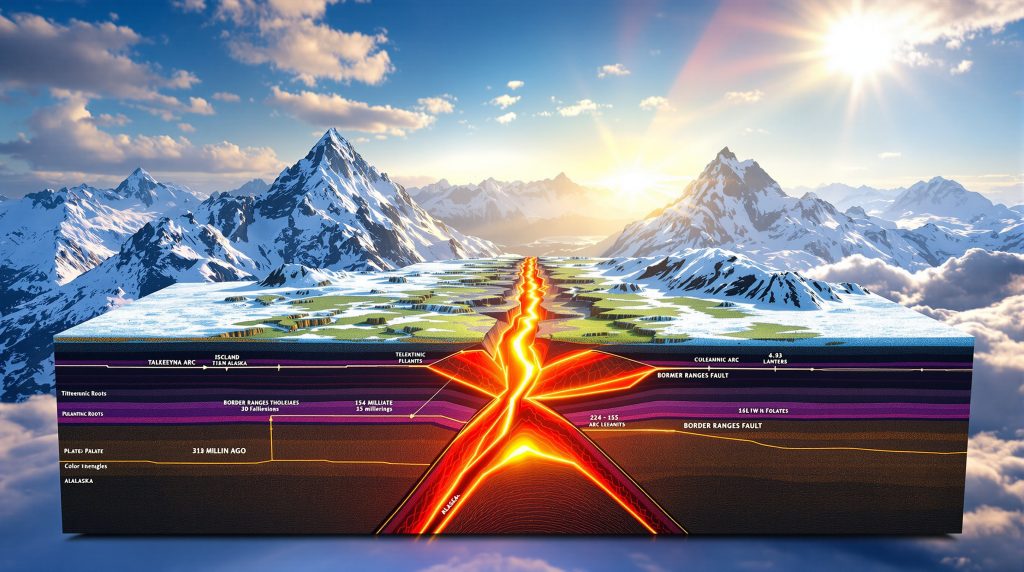Understanding the Talkeetna Arc: A Window into Subduction Initiation
The Talkeetna Arc represents one of Earth's most exceptional ancient oceanic island arcs, offering geologists a rare three-dimensional view of arc evolution. Located in south-central Alaska, this Late Triassic to Jurassic magmatic complex (approximately 232-153 million years old) provides extraordinary insights into subduction initiation processes—the critical moment when one tectonic plate begins descending beneath another.
Unlike many ancient arcs that have been heavily deformed or only partially preserved, the Talkeetna Arc exposes a nearly complete crustal section from upper volcanic layers to deep plutonic roots. This exceptional preservation makes it a natural laboratory for understanding how subduction zones form and evolve, with significant implications for modern plate tectonic processes worldwide.
The arc's crustal thickness reaches approximately 30-35 km, representing a complete cross-section of an oceanic arc system. This unique geological feature has made the Talkeetna Arc what researchers call "one of the premier transcrustal magmatic systems of an oceanic system in the world."
The Tectonic Setting and Formation
Ancient Alaskan Geography
During the Late Triassic period (approximately 232-210 million years ago), what would eventually become Alaska looked dramatically different from today's geography. The region consisted of several distinct crustal fragments or "terranes" surrounded by ancient oceans:
- The Peninsula terrane (hosting most of the Talkeetna Arc)
- The Wrangellia terrane (containing flood basalts)
- The Alexander terrane (to the southeast)
These terranes, collectively forming what geologists call the "Insular Superterrane" or "Wrangellia Composite Terrane," were positioned far from the North American continental margin, existing as isolated crustal blocks in the ancient Pacific Ocean.
The Sequence of Subduction Initiation
Recent geochemical and geochronological research reveals that subduction initiation beneath the Talkeetna Arc followed a specific sequence that mirrors patterns observed in younger subduction zones:
-
Initial Extension Phase (232+ Ma): As subduction began, the upper plate experienced extension and decompression melting, producing basaltic magmas with compositions similar to mid-ocean ridge and ocean island basalts.
-
Transition Phase (232-217 Ma): As the downgoing slab reached greater depths, fluids released from the subducting plate began influencing magma composition, creating a distinctive geochemical signature marking the transition to true subduction.
-
Mature Arc Phase (217-153 Ma): Full subduction-related magmatism developed, producing the classic calc-alkaline volcanic and plutonic rocks that characterize mature island arcs.
This progression from extension-related to subduction-influenced magmatism provides critical time constraints on how quickly subduction zones stabilize after initiation.
Evidence Supporting the Talkeetna Subduction Initiation Model
Geochemical Fingerprints
The most compelling evidence for subduction initiation comes from whole-rock geochemical analyses of the Talkeetna Arc's oldest volcanic rocks, particularly on the Kodiak Archipelago. These analyses reveal:
- A clear progression from titanium-rich basalts (typical of non-subduction settings) to titanium-poor basalts (characteristic of subduction zones)
- Increasing thorium enrichment up-section, indicating growing influence of slab-derived fluids
- Transition from enriched mid-ocean ridge basalt (E-MORB) compositions to island arc tholeiite compositions
Researchers use titanium and vanadium ratios—both immobile trace elements resistant to metamorphic alteration—to classify these ancient volcanic rocks by tectonic setting. This approach has proven critical for interpreting rocks that have undergone metamorphism.
Structural and Stratigraphic Evidence
Beyond geochemistry, field relationships provide strong support for the subduction initiation model:
- The Border Ranges Fault, which runs through south-central Alaska, marks the ancient subduction boundary
- Blueschist facies metamorphic rocks with Early Jurassic ages (204 Ma) indicate high-pressure, low-temperature conditions typical of subduction zones
- The stratigraphic progression from basaltic lavas to more evolved volcanic rocks mirrors the expected maturation of an arc system
The Border Ranges Fault represents the paleo-subduction zone location, with blueschist-facies rocks juxtaposed against the early arc plutons. The current position of this fault against what would have been the early arc has been interpreted as the result of subduction erosion, where the forearc was progressively removed, bringing the trench closer to the arc over time.
Comparing the Talkeetna Arc to Vancouver Island Geology
Parallel Geological Histories
The geological story of the Talkeetna Arc shares remarkable similarities with Vancouver Island's geology, suggesting connected tectonic histories:
| Feature | Talkeetna Arc (Alaska) | Vancouver Island (British Columbia) |
|---|---|---|
| Paleozoic Basement | Permian volcanic-clastic conglomerate; xenoliths in Mount Redoubt | Sicker Group (Paleozoic arc) |
| Flood Basalts | Nikolai Flood Basalts (230-225 Ma) | Karmutsen Flood Basalts (230-225 Ma) |
| Arc Magmatism | Talkeetna Arc (232-153 Ma) | Bonanza Arc (210-170 Ma) |
| Tectonic Setting | Built on Peninsula/Wrangellia terranes | Built on Wrangellia terrane |
These parallels suggest both regions were part of a larger tectonic system spanning thousands of kilometers along the ancient Pacific margin, with the Talkeetna and Bonanza arcs potentially representing different segments of the same subduction system.
Key Differences and Remaining Questions
Despite these similarities, important differences exist:
- The Talkeetna Arc shows clearer evidence of subduction initiation processes
- The Peninsula terrane basement is less well-exposed than Vancouver Island's Sicker Group
- The timing and nature of terrane accretion to North America differs between regions
The Peninsula terrane basement is "almost entirely not exposed, just in a couple places," with one key location being Puale Bay on the Alaska Peninsula. This contrasts with Vancouver Island where the relationship between the Sicker Group basement, Karmutsen flood basalts, and Bonanza Arc is more clearly visible in the field.
The question of how these formerly connected terranes became separated remains open, with different models proposing various configurations of strike-slip displacement at different times.
Methods Used to Study Subduction Initiation
Advanced Analytical Techniques
Researchers employ sophisticated analytical methods to decipher the Talkeetna Arc's history:
- Chemical Abrasion Thermal Ionization Mass Spectrometry (CA-TIMS): Provides high-precision dates on zircon crystals, allowing researchers to constrain the timing of key events to within ±0.1 million years
- Whole-rock geochemistry: Measures major and trace element compositions to track changes in magma sources and processes
- Immobile element ratios: Utilizes elements like titanium and vanadium that resist alteration to classify ancient volcanic rocks by tectonic setting
- Detailed field mapping: Documents spatial relationships between different rock units, crucial for reconstructing the three-dimensional architecture of the arc
The integration of high-precision dating with geochemical analyses has been particularly powerful for identifying the exact moment when subduction influence began to appear in the magmatic record.
Field-Based Approaches
Field investigations in Alaska present unique challenges and opportunities:
- Coastal exposures on the Kodiak Archipelago and Alaska Peninsula provide exceptional cross-sections through the arc system
- Remote locations require boat access and specialized field logistics
- Mapping in these areas builds on pioneering work conducted in the 1970s by researchers from UC Santa Cruz who mapped the archipelago coastline using inflatable boats
- Modern studies benefit from GPS technology, digital mapping tools, and the ability to collect targeted samples for laboratory analysis
The iterative approach of field mapping combined with laboratory analysis has proven particularly effective. As one researcher explains: "We collected a bunch of samples for whole rock geochemistry… went back, had about 20-25 samples analyzed in that first year, and then came back with the knowledge of what we were seeing with that and used that to finish up the mapping."
Why Subduction Initiation Matters
Implications for Plate Tectonic Theory
Understanding how subduction zones form addresses a fundamental question in plate tectonic theory: how does a new subduction zone start? This process:
- Controls the long-term evolution of Earth's tectonic plates
- Influences global patterns of volcanism and earthquake activity
- Drives the recycling of oceanic crust back into the mantle
- May help explain major transitions in Earth's tectonic configuration through time
The Talkeetna Arc provides one of the best natural laboratories for studying these processes in the rock record, with implications for understanding how subduction operates in modern systems like the Izu-Bonin-Mariana arc.
Applications to Resource Exploration
Subduction initiation also has practical implications:
- Many economic mineral deposits form in arc environments
- Understanding the evolution of arc systems helps predict where valuable resources might be located
- The timing and style of subduction initiation influences the types of deposits that may form
- Early arc magmatism may create specific metallogenic conditions not present in mature arcs
By reconstructing the detailed history of the Talkeetna Arc, geologists gain insights that may guide future exploration efforts in similar geological settings worldwide. Furthermore, the mineral exploration importance in these regions cannot be overstated as they often host valuable resources.
The Evolution of the Talkeetna Arc After Subduction Initiation
Arc Evolution and Maturation
Following initiation, the Talkeetna Arc evolved through several stages:
- Early Arc Stage (217-200 Ma): Characterized by the Alagnak batholith on the Kodiak Archipelago and early volcanic activity
- Arc Migration (200-180 Ma): The focus of magmatism shifted slightly inboard, with plutons emplaced in the Chugach Mountains (ranging from 201-180 Ma)
- Mature Arc Stage (180-153 Ma): Magmatism concentrated in the Talkeetna Mountains and Alaska Peninsula, producing voluminous plutonic and volcanic rocks
Throughout this evolution, the arc maintained a north-dipping subduction polarity, with the trench position gradually migrating through subduction erosion processes. Understanding the mineral deposit tiers that formed during these different stages provides crucial information for modern exploration efforts.
Collision and Accretion
The final chapter in the Talkeetna Arc story involved its incorporation into the North American continent:
- Around 160-150 million years ago, the arc and associated terranes began colliding with the North American margin
- This collision marked the transition from oceanic subduction to continental collision tectonics
- Subsequent deformation and uplift exposed different crustal levels of the arc, creating the spectacular exposures visible today
- Later strike-slip faulting further modified the original arc geometry
These processes transformed an oceanic island arc into part of the North American Cordillera, preserving a remarkable record of subduction initiation and arc evolution. The subduction zones tectonic evolution across this region has been particularly well-documented.
The Significance of the Talkeetna Arc for Modern Geology
The Talkeetna Arc stands as one of Earth's premier natural laboratories for studying subduction initiation and arc evolution. Its exceptional preservation allows geologists to reconstruct the sequence of events that occurred when a new subduction zone formed over 230 million years ago.
By combining detailed field mapping with cutting-edge analytical techniques, researchers continue to extract new insights from this ancient arc system. The parallels with Vancouver Island geology highlight the regional extent of these processes and underscore the importance of the Talkeetna Arc for understanding the tectonic evolution of western North America.
Recent work has focused on previously unexplored aspects of the arc's history. While earlier studies like the Continental Dynamics NSF project in the 2000s examined the mature arc system, current research is specifically targeting the subduction initiation record preserved in the Lower Shuyak Formation basalts on the Kodiak Archipelago. This approach has yielded the first detailed chronology of subduction initiation, with implications for understanding how quickly these systems develop and stabilize.
As analytical methods continue to advance, the Talkeetna Arc will likely yield even more detailed information about the timing, mechanisms, and consequences of subduction initiation—one of the most fundamental processes in plate tectonic theory. Proper use of geological logging codes has been essential in documenting these complex systems.
Looking Ahead: Future Research Directions
Future studies of the Talkeetna Arc may focus on:
- Integrating the volcanic and plutonic records to develop a more complete picture of early arc evolution
- Comparing the timing of subduction initiation in Alaska with other paleo-Pacific margin arcs
- Refining models of terrane displacement to explain the current separation between formerly connected segments
- Applying insights from the Talkeetna Arc to understand modern subduction initiation events
Through continued investigation of this remarkable geological feature, scientists will further unravel the complex processes that shape our dynamic planet. Understanding the relationship between mineralogy & ore economics in these ancient systems also provides valuable context for the mining industry evolution we're witnessing today.
Interested in Spotting the Next Major Mineral Discovery?
Discovery Alert's proprietary Discovery IQ model instantly identifies significant ASX mineral discoveries, providing actionable insights before the broader market catches on. Explore our dedicated discoveries page to understand how major geological findings like the Talkeetna Arc translate into exceptional investment returns.




